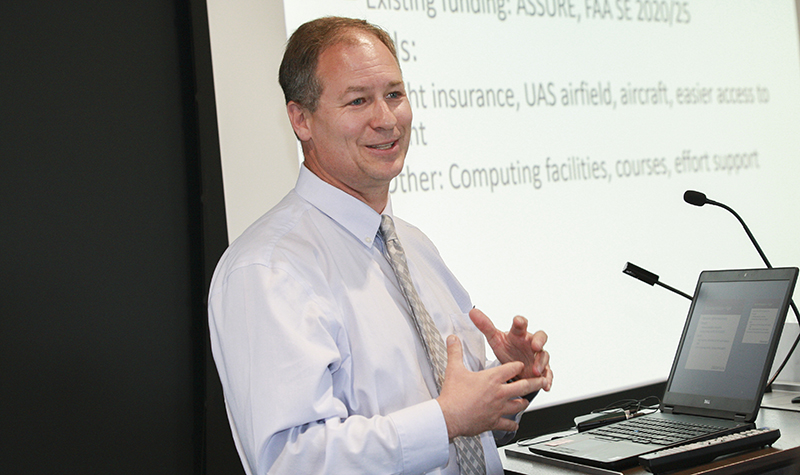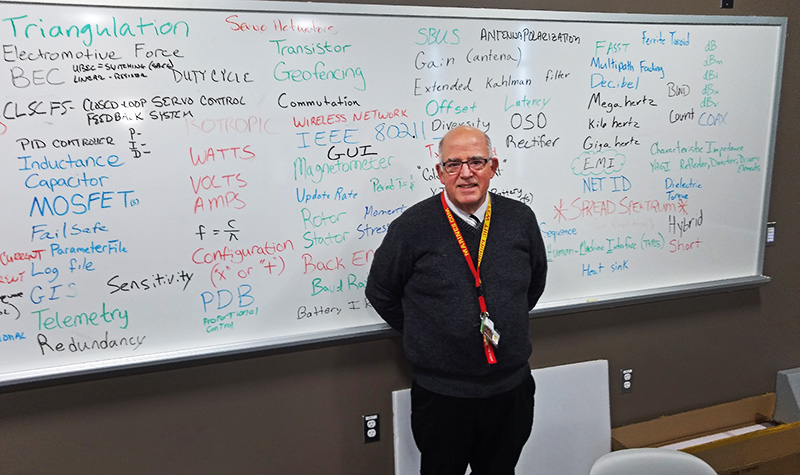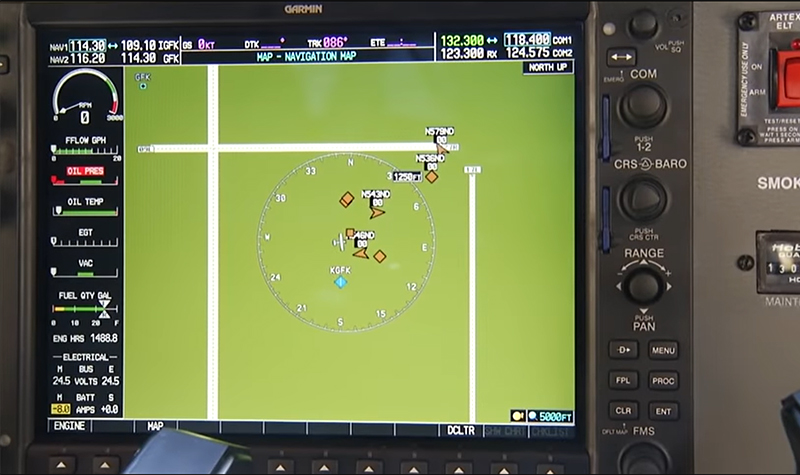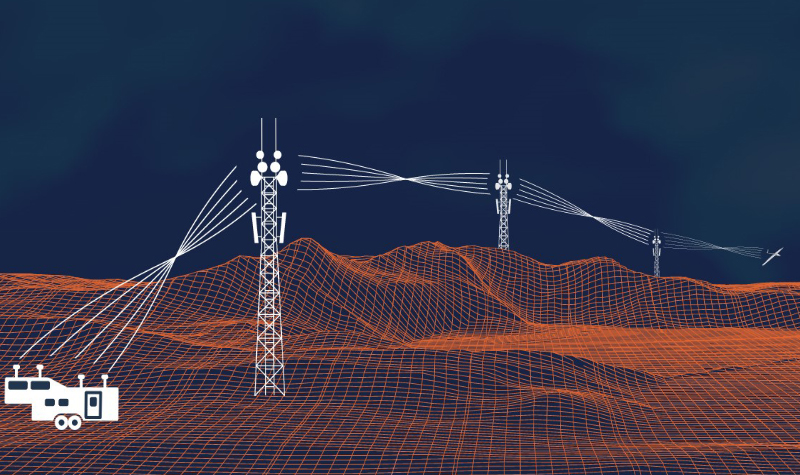How UND blazed the trail for UAS
Across nearly two decades, UND research built foundations for local, national and international UAS activity

“Mr. Watson, come here. I want to see you.”
With those words on March 10, 1876, Alexander Graham Bell made the first phone call, summoning his assistant from the next room — and starting the world’s telecommunications revolution.
One day, when drone deliveries of groceries are routine and drone taxis zip travelers between rural airports and skyscraper downtowns, historians will look for a similar origin story for the civilian use of unmanned aerial systems (UAS). They might find what they’re looking for in the classrooms, offices and simulators of UND.
Because that fantastic future of shared airspace had to start somewhere. And researchers at UND were among the first to imagine that future and start to make it come about.
Last week’s 14th Annual UAS Summit & Expo featured the announcement that North Dakota will be the home of Vantis, America’s first statewide UAS beyond visual line of sight (BVLOS) network.
Vantis will enable UAS applications known now and yet to be conceived – from package and medical delivery to utility inspections, search and rescue operations, and agricultural uses. It’s a major development on the world’s path to unmanned air taxis and even more futuristic uses of UAS.
And in talking about Vantis, Nick Flom, executive director for Vantis’ managing entity, the Northern Plains UAS Test Site, gives great credit to UND.
UND and the UAS ecosystem it helped develop were instrumental in securing $28 million in support from the North Dakota Legislature in 2019 for the BVLOS network’s development, Flom said.
“UND has built up some really smart people in this arena that have allowed us, the Test Site, to be at the peak of our game in order to make something like Vantis work,” he said.
“We’re able to do this in North Dakota because of UND’s history of research on this subject.”

Primed to answer the call
Of course, the history of North Dakota’s UAS ecosystem and its all-in focus on BVLOS goes back a lot longer than 2019.
“We started working on detect-and-avoid challenges in about 2007 or 2008,” said Mark Askelson, executive director of the UND Research Institute for Autonomous Systems and Associate Dean of Research in the John D. Odegard School of Aerospace Sciences, at the recent summit. Askelson was referring to the technology UAS operators use to prevent mid-air collisions.
“The U.S. Department of Defense had a number of locations in the United States where they wanted to fly missions beyond visual line of sight, but they couldn’t do it,” he said.
That’s because the national airspace isn’t like that of a warzone, where the Department of Defense (DoD) can manage the airspace however it wants, explained Askelson. Federal Aviation Administration (FAA) rules allow private citizens to fly at their leisure, without a need to broadcast their location. These types of flyers – planes, gliders, balloons, birds or otherwise – are regarded as “non-cooperative.”
In order to make airspace viable for domestic drone use, the DoD needed to create solutions for detecting non-cooperative aircraft without restricting flight.
UND, with its nationally renowned flight school and regular FAA partnership in matters of flight safety and research, was the right place at the right time with the research tools to meet the DoD and FAA’s challenge.
“The reason university research matters is because we’re solving problems people need solved,” Askelson said. “We wouldn’t be where we are today without a lot of different things and contributors, but research has been a key part of that.”

Bedrock research for UAS ecosystem
At UND, Associate Professor of Aviation Ben Trapnell’s experience was vital in the University’s starting to meet the DoD’s original challenge.
Back in his days as a student at the U.S. Naval Academy and as a naval aviator, Trapnell studied phased array radars. He learned how accurately they could surveil surrounding airspace from the ground, and that their capabilities had improved to where they could spot objects as small as birds.
Once at UND, Trapnell heard of work others were doing with the same radars on a tornado-prediction project at the University of Oklahoma. Their idea of mounting phased array radars on cell phone towers gave him the idea that such technology might provide an additional function: detect-and-avoid. Soon, representatives of an Air Force program called UAV Battlelab were coming to UND, having learned from Trapnell and others about the BVLOS potential of the University’s experience with phased array radar.
Then-U.S. Sen. Byron Dorgon, D-N.D., was instrumental in creating this federal connection to UND. Dorgan secured the funding for UAS-related research, through UAV Battlelab, that is the bedrock for the UAS ecosystem North Dakota has today.
UND and its partners’ BVLOS research settled on a two-pronged approach. The first involved building a network of phased array radars.
Forming a triangle with these radars, 40 miles to a side, was the foundational idea behind GPAR-RMS – the Ganged Phased Array Radar Risk Management System – the first ground-based detect-and-avoid system for UAS.
The radars on the three corners could constantly scan. If one radar was needed to track a potential hazard, the other two could provide the redundancy needed to ensure a clear flight path for a UAS.

Cross-campus collaborations to find solutions
But a ground-based array wasn’t enough, especially for the job of enabling unmanned aircraft to avoid potential hazards autonomously – that is, without direction from a controller.
For that task, an onboard system was required. Fortunately, UND engineers once again proved up to the challenge.
Researchers at the UND College of Engineering & Mines worked on a payload solution incorporating highly specialized transponders.
Essentially, the radar array architecture developed in Aerospace addressed the BVLOS flight question, while the payload solutions developed in Engineering enhanced safety by enabling autonomous calculations and course corrections.
With an operational radar array that could provide guidance to operators, and a detect-and-avoid payload for UAS that could take autonomous action if necessary, UND had developed patentable ideas. Two UND patents were secured and licensed for the overall detect-and-avoid system architecture (GPAR-RMS) and the transponder-based payload solution.
Along with detect-and-avoid technology, UND advanced Automatic Dependent Surveillance-Broadcast or ADS-B technology – technology by which an aircraft broadcasts its position, altitude and velocity every second. This application of ADS-B demonstrated the benefit of cooperative data in creating shared airspace, said Askelson in a recent interview with UND Today.
Throughout the 2010s, ADS-B transponders became a standard in general aviation worldwide. In fact, as of January 2020, all aircraft flying in the United States above 10,000 feet (more technically: Classes A, B, C and E airspace) are required to carry such transponders.
Meanwhile, at UND, “we were executing flight tests around 2009 where we were testing with simulated intruders, and the aircraft was detecting and avoiding them, using ADS-B-based technology, autonomously,” Askelson said. “That was a big deal.”
The Mitre Corp. agreed. The nonprofit, federally funded R&D company – whose work helped create the national airspace as it’s known today – was impressed by how UND harnessed the ADS-B technology first developed by Mitre. This interaction set the stage for UND’s continued role in BVLOS work.

Milestone for North Dakota airspace
The Limited Deployment – Cooperative Airspace Project (LD-CAP) was that next step. Backed by state funding, UND partnered with Mitre and the NASA-Langley Research Center to integrate detect-and-avoid algorithms onboard NASA aircraft.
Besides generating another round of valuable research at UND, the NASA project also brought about a significant outreach effort.
In cooperation with the North Dakota Aeronautics Commission, UND procured a number of ADS-B units to provide to pilots flying regularly in the state. Thus, UND developed an awareness campaign to educate pilots on the systems’ benefits and create a friendlier airspace in North Dakota for UAS integration.
Speaking with UND Today, Flom called this a milestone development.
“In North Dakota, most general aviators are flying below 10,000 feet. So, until relatively recently, there wasn’t much motivation to equip with ADS-B,” Flom said.
Having those previously non-cooperative aircraft broadcasting their location was a win for drone integration.
“The fact that LD-CAP helped equip the state’s fleet – meaning private owners – through subsidies and programs made us the most cooperative state in the country for ADS-B traffic,” Flom said. “That’s incredible.”
The steps following LD-CAP further refined UND’s inventions. In particular, UND’s work helped set the stage for Vantis: a latticework of radars and other detection gear, much of it installed on existing infrastructure such as cell-phone towers, that will provide airspace surveillance and sophisticated radio communications to UAS operators and researchers.
What was once confined to a 40-miles-on-a-side triangle will be able to span an entire state.

Research revolutionizing tech, right here at UND
Summarizing his thoughts on how UND was able to make the most of its UAS opportunities, Askelson said he was sure of one thing.
“This started with people in our ecosystem recognizing the industry’s importance,” he said, naming UND Aerospace deans past and present in Bruce Smith and Paul Lindseth, respectively.
“Our leaders at UND, in Bismarck and in Washington coalesced around unmanned aircraft. They set out a strategy of opening opportunity sets for us both at the state and federal level.”
State efforts such as the Research ND Grant Program, the 2006 designation of UND’s UAS work as a North Dakota Center of Excellence and the push to sponsor and stand up the Northern Plains UAS Test Site, were vital.
And, with respect to the FAA and its position on UAS integration, things have come a long way.
“Looking at where we are now, the FAA is an active partner in trying to solve these problems,” Askelson explained. “Going from 2005 to today, where we now have test sites, the Integration Pilot Program and the ASSURE research program – it’s really evolved.”
Research efforts at UND helped make beyond visual line of sight operations for unmanned aerial systems possible. It’s a story of generating expertise through fundamental research and then expanding discovery through focusing on a new set of challenges – UAS BVLOS, detect-and-avoid, integration into the national airspace and, more broadly, autonomy.
Nearly two decades in the making, UND faculty and students, in collaboration with state, federal and industry partners, used the power of research innovation to build the foundation for Vantis and the ensuing vast commercial activity it will support in North Dakota and beyond.
So, when historians pore through emails and hard drives in search of the beginning of this revolutionary technology, they may – as happened with the Bell story – distill many careers and layers of innovation into a representative moment.
Chances are good that they’ll situate the moment at UND. Because at the dawn of the industry, many of the smartest and most capable UAS-minded people were right here.



